
This Infographic Maps the Outbreak and Spread of Ebola
Rahul Kalvapalle — August 1, 2014 — Lifestyle
References: huffingtonpost & huffingtonpost
Huffington Post's resident Infographic Editor Jan Diehm put together a fascinating and disturbing infographic that charts the spread of Ebola, the deadly virus that has killed many people in West Africa and has led to fears of a potential global spread.
The infographic displays a map of Africa, and shows which strains of the virus have caused trouble in which region of the continent. The graphic shows that there are four strains of Ebola -- the Zaire, Sudan, Ivory Coast and Bundibugyo strains.
There is also an interesting timeline that charts out the number of recorded Ebola cases by year over nearly four decades. Disturbingly, this timeline shows that while there were no recorded Ebola outbreaks between 1980 and 1993, there have been over 800 cases in 2014 alone.
The infographic also shows how the spread of Ebola actually takes place. It claims that fruit bats are the most likely natural host for the virus; the disease is transmitted to gorillas and other animals who come into contact with the bats' saliva. Humans can then contract the virus via close contact with infected animals.
The infographic displays a map of Africa, and shows which strains of the virus have caused trouble in which region of the continent. The graphic shows that there are four strains of Ebola -- the Zaire, Sudan, Ivory Coast and Bundibugyo strains.
There is also an interesting timeline that charts out the number of recorded Ebola cases by year over nearly four decades. Disturbingly, this timeline shows that while there were no recorded Ebola outbreaks between 1980 and 1993, there have been over 800 cases in 2014 alone.
The infographic also shows how the spread of Ebola actually takes place. It claims that fruit bats are the most likely natural host for the virus; the disease is transmitted to gorillas and other animals who come into contact with the bats' saliva. Humans can then contract the virus via close contact with infected animals.
Trend Themes
1. Spread of Ebola - Identifying and tracking the spread of Ebola to prevent further outbreaks.
2. Ebola Strains - Understanding the different strains of Ebola to develop targeted treatments and vaccines.
3. Ebola Timeline - Analyzing the historical progression of Ebola cases to identify patterns and improve prevention strategies.
Industry Implications
1. Healthcare - Developing advanced diagnostic tools, treatments, and preventive measures for Ebola.
2. Pharmaceuticals - Researching and producing effective vaccines and antiviral medications for Ebola.
3. Data Visualization - Creating interactive infographic tools to educate and raise awareness about the spread and impact of Ebola.
1.8
Score
Popularity
Activity
Freshness























